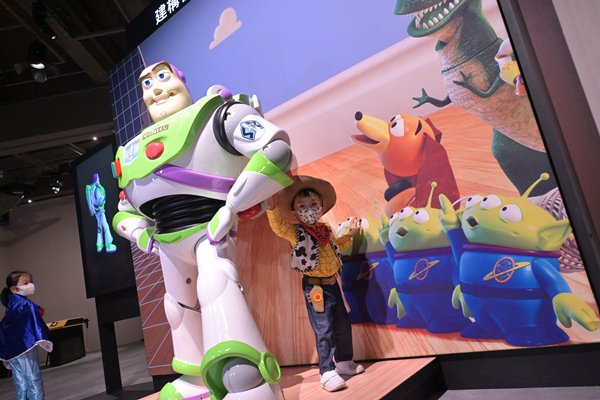The Science Behind Storytelling

Toy Story, Monsters University, Finding Nemo and Cars are just a few of the most beloved films made by Pixar Animation Studios. But how do the animators bring each story to life with the use of mathematics and physics to create lively characters and realistic scenes?
Families and movie lovers have been flocking to the Science Museum to discover the wonders of computer animation at its extremely popular The Science Behind Pixar exhibition, which the museum has spent five years organising.
Interactive exhibits
Apart from taking selfies with animated characters like Buzz Lightyear, Sulley and Dory, visitors can walk through eight sections that detail the meticulous filmmaking process which includes modelling, rigging, surfaces, sets and cameras, animation, simulation, lighting and rendering.
Primary 1 student Kobe Chan is a science lover. After touring the show, he wanted to spend the entire day playing in its 50-plus interactive exhibits.
“I can now explain the basics on how to create a maquette or scale model of the characters, a digital wireframe and colour it. This exhibit is great fun and it makes me want to become a cameraman when I grow up,” he said.
Mr Choi booked a visit immediately after the e-booking system was opened. He explained that his son, who is in lower kindergarten, is very curious about how lighting effects are used to highlight Dory’s underwater environment.
“I never thought about the science behind the scenes. Although my son is too young to understand, I hope he can grasp some basic knowledge about science,” he said.
Creative process
In addition to the exhibition, a series of workshops, talks and school programmes are available.
From September, Hong Kong production staff from Pixar Animation Studios will hold an online talk series.
One of the talks will feature Maria Lee who has worked at Pixar for more than 16 years. She is a character shading artist who helps create colours and textures for animated characters.
The sea monster in Pixar’s new film Luca is one of Maria's masterpieces. She described the animation process as a rich blend of science and arts.
"I want the hair to (feel) like seaweed, (appear more) translucent. So what I have to do is (to apply) all the research (conducted) and the aesthetics that the art department has designed."
She said the process of creating animation on a computer is another challenge.
"You have to calculate how the light hits that material - does it feel like seaweed? The understanding of how colours work together as well as how specularity will respond - would it feel more like plastic or does it feel more like metal - (is just a portion of) all the vocabularies that I learnt from (studying) computer arts."
Embarking on STEAM career
Science Museum Director Paulina Chan said the STEAM educational approach, which includes science, technology, engineering, arts and mathematics, has been at the forefront of education in recent years.
She expressed hope that the exhibition will inspire the younger generation to pursue careers in innovation and technology.
“The Government has (devoted) a lot of resources to the education sector and also the private industry to nurture a lot of entrepreneurs to let them know there is a new horizon in the innovation and technology (industry).
“Through this exhibition, we can interpret STEAM from a new angle, for example, how you interpret science, mathematics and physics, and combine it with arts to create all these exhibits. I think this is a very good example of showcasing the STEAM application,” she added.
The exhibition closes on December 1. Online reservations can be made up to seven days in advance.
Hotline Eases Carers' Burden
Mrs Lee, 74, and her 84-year-old husband are a doubleton elderly household relying on Comprehensive Social Security As... Read more
District Governance: Cameras Boost Security
Whether at busy intersections or tranquil street corners, Hong Kong has silent sentinels safeguarding citizens. Thr... Read more
Meals Tailor-made For Patient Needs
The bustling kitchen of Kowloon Hospital serves approximately 1,400 inpatients per meal. The menus are designed to ... Read more
Talent Volunteers Share In Festive Fun
Staged ahead of the Mid-Autumn Festival, a lantern workshop organised by the Talent+ Volunteer Programme, run by Hong ... Read more
Hydrogen Paves Low-carbon Future
Hydrogen energy is regarded as a low-carbon energy with development potential, as the world is striving to phase out f... Read more
Drones Offer Medical Delivery Hope
Transportation to Cheung Chau has always depended on ferries, which are subject to scheduling constraints. In the even... Read more

